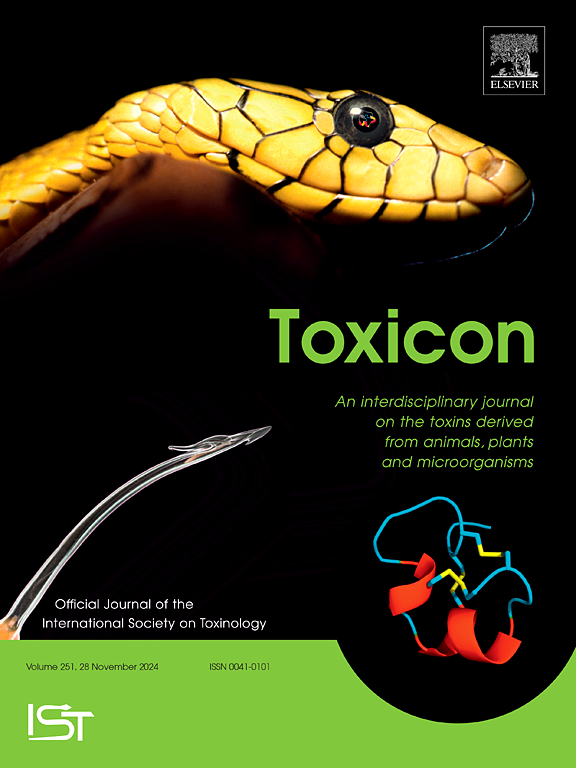普通眼镜蛇(Naja naja)咬伤后的 ATAK(肾上腺素、Takotsubo、过敏性休克和 Kounis 超敏反应相关综合征):斯里兰卡病例报告。
IF 2.6
4区 医学
Q2 PHARMACOLOGY & PHARMACY
引用次数: 0
摘要
一名 68 岁的妇女被印度眼镜蛇(Naja naja)咬伤后,出现了过敏性休克、塔克次博心肌病和库尼斯综合征。她最初被诊断为接触眼镜蛇毒液引起过敏性休克后的急性冠状动脉综合征,这表明她患有库尼斯综合征。通过超声心动图、心电图和几乎完全逆转的运动障碍心肌证实了塔克苏博心肌病。肾上腺素最初用于治疗过敏性休克,而去甲肾上腺素静脉注射用于治疗低血压,这可能会诱发 ATAK 综合征。根据病史、低血压、肌钙蛋白升高、超声心动图显示多个运动障碍节段以及血管造影显示冠状动脉血管正常,可以确诊该病。本文章由计算机程序翻译,如有差异,请以英文原文为准。

ATAK (Adrenaline, Takotsubo, anaphylaxis, and Kounis hypersensitivity-associated syndrome) following common cobra (Naja naja) bite: A case report from Sri Lanka
A 68-year-old woman, after an Indian cobra (Naja naja) bite, developed anaphylaxis, Takotsubo cardiomyopathy, and Kounis syndrome. She was initially diagnosed with acute coronary syndrome after anaphylaxis due to exposure to cobra venom, indicating Kounis syndrome. The echocardiogram, electrocardiogram, and almost complete reversal of dyskinetic myocardium established Takotsubo cardiomyopathy. Adrenaline, initially given for anaphylaxis, and noradrenaline as an intravenous infusion for hypotension potentially precipitated the ATAK complex. The diagnosis was established by history, low blood pressure, elevated troponin, numerous dyskinetic segments in the echocardiogram, and normal coronary vessels in the angiogram.
求助全文
通过发布文献求助,成功后即可免费获取论文全文。
去求助
来源期刊

Toxicon
医学-毒理学
CiteScore
4.80
自引率
10.70%
发文量
358
审稿时长
68 days
期刊介绍:
Toxicon has an open access mirror Toxicon: X, sharing the same aims and scope, editorial team, submission system and rigorous peer review. An introductory offer Toxicon: X - full waiver of the Open Access fee.
Toxicon''s "aims and scope" are to publish:
-articles containing the results of original research on problems related to toxins derived from animals, plants and microorganisms
-papers on novel findings related to the chemical, pharmacological, toxicological, and immunological properties of natural toxins
-molecular biological studies of toxins and other genes from poisonous and venomous organisms that advance understanding of the role or function of toxins
-clinical observations on poisoning and envenoming where a new therapeutic principle has been proposed or a decidedly superior clinical result has been obtained.
-material on the use of toxins as tools in studying biological processes and material on subjects related to venom and antivenom problems.
-articles on the translational application of toxins, for example as drugs and insecticides
-epidemiological studies on envenoming or poisoning, so long as they highlight a previously unrecognised medical problem or provide insight into the prevention or medical treatment of envenoming or poisoning. Retrospective surveys of hospital records, especially those lacking species identification, will not be considered for publication. Properly designed prospective community-based surveys are strongly encouraged.
-articles describing well-known activities of venoms, such as antibacterial, anticancer, and analgesic activities of arachnid venoms, without any attempt to define the mechanism of action or purify the active component, will not be considered for publication in Toxicon.
-review articles on problems related to toxinology.
To encourage the exchange of ideas, sections of the journal may be devoted to Short Communications, Letters to the Editor and activities of the affiliated societies.
 求助内容:
求助内容: 应助结果提醒方式:
应助结果提醒方式:


